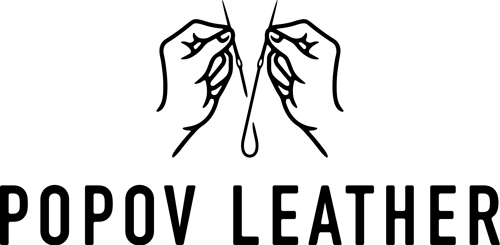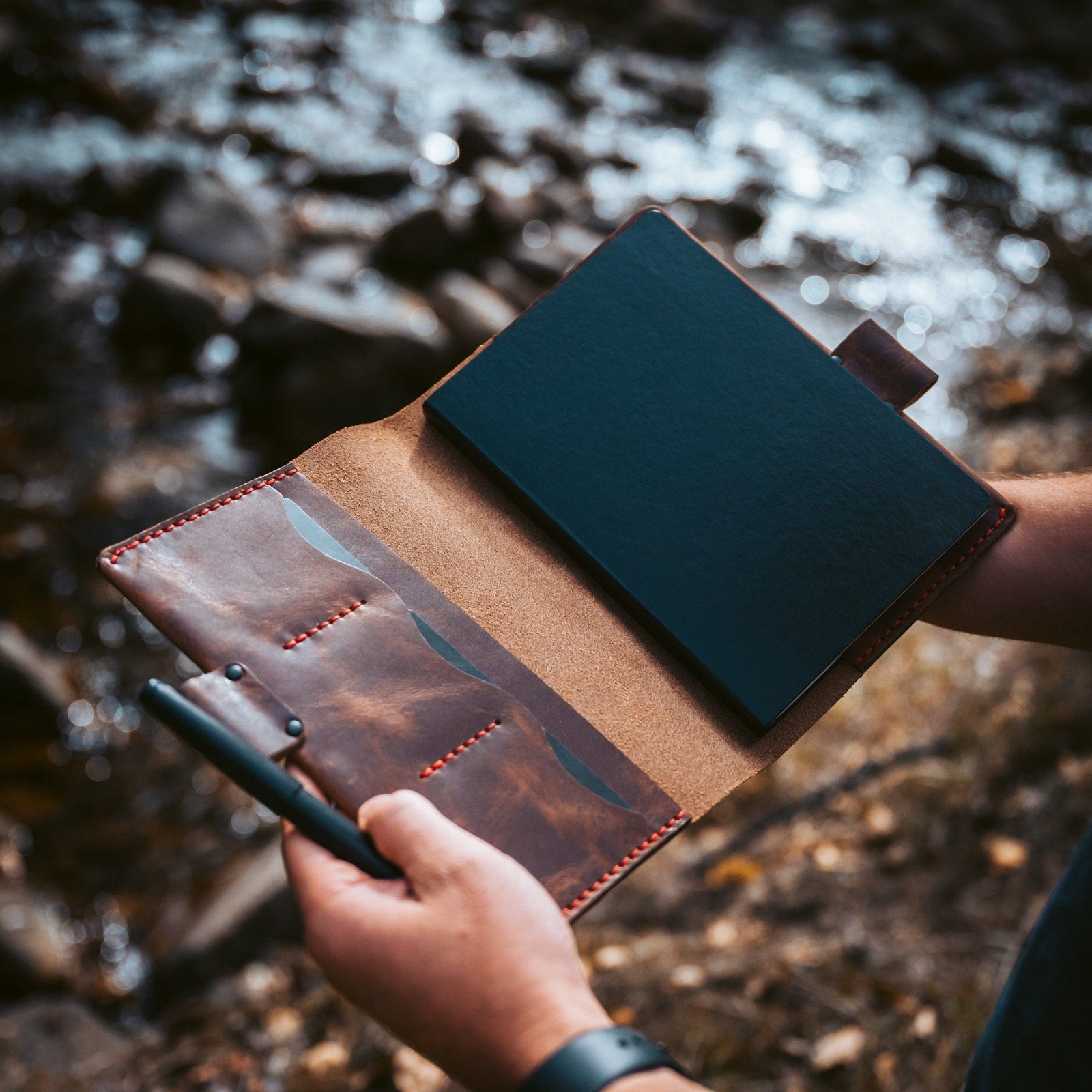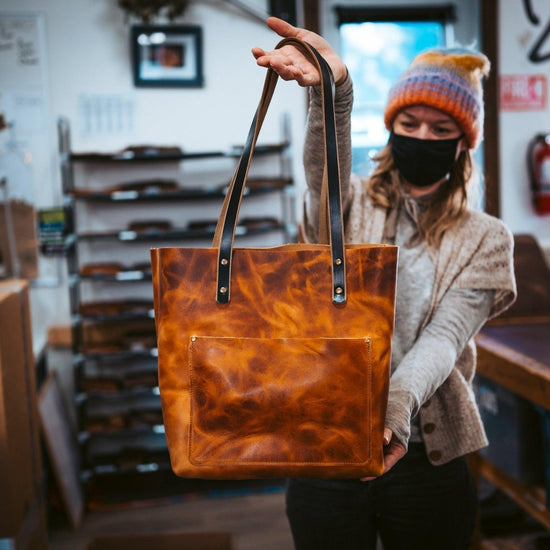Every once in a while, a customer will reach out and ask if our leather is toxic or if it’s bad for the environment. This has become more prevalent in recent years as the leather industry, as a whole, has come under media scrutiny.
We get it! You want your family to be safe, and you want to ensure you’re not contributing to environmental waste. At Popov Leather, we have those same concerns. That’s why we work with Horween Leather, one of the few tanneries left in the United States who not only abides by the U.S. Environmental Protection Agency’s standards but actually exceeds them.
Keep reading this classic leather working guide to learn about some of the potential environmental and toxicity concerns with leather, and how we strive to combat those concerns here at Popov Leather.
Table of Contents
Is Leather a Responsible Material to Use?
Before taking a look at the specific leather we work with at Horween Leather, it’s first important to look at the leather industry as a whole.
Leather is created from animal hides. For this reason, it’s impossible to put aside environmental concerns entirely. There is a cost to working with animals; however, it’s a cost that many leather tanneries are aware of and working to mitigate.
That being said, there are some environmental risks to all materials. Let’s take a look at some of the specific concerns when working with leather, as well as how those concerns compare to common leather alternatives.
Common Safety Concerns When Working on Leather Projects
One of the major safety concerns with leather has to do with the working conditions in tanneries. Leather is tanned using a variety of chemicals, and without proper safety regulations in place, this can cause damage to the workers.
You’ll sometimes see this in countries with minimal law enforcement and low safety standards. In these countries, you may even see children working with dangerous chemicals, which is a concern on a number of different fronts.
Another major concern regarding the toxicity of leather comes from the chromium tanning process, which has the potential to produce toxic gasses, including carcinogenic chromium (IV). Numerous tanneries in the US have been closed due to the production of these toxic gasses. However, this leather byproduct can be mitigated by using safe leather production protocols.
Benefits of the Leather Industry
Tanning leather has been practiced for thousands of years. In fact, it’s one of the oldest known industries. And while there are reasons to be concerned about toxic leather production, there are some important reasons to find safe ways to keep this industry thriving.
For one thing, using animal skins to create leather ensures there’s no excess waste in the meat industry. As a result, the leather industry helps keep thousands of farmers employed and bolsters the economy.
Additionally, leather manufacturers are often at the forefront of efforts toward improving the welfare of animals. Quality leather is produced by thick, healthy hides, which you can’t get when animals are being mistreated. As a result, the leather industry helps keep the meat manufacturing industry in check.
The durability of leather also allows consumers to enjoy a minimalist lifestyle. When you invest in a high-quality leather belt, for example, you know that you won’t need another belt in your lifetime. In fact, at Popov Leather, our heirloom-quality products come with a lifetime guarantee.
Finally, when you have finished with a leather product, you can take comfort in the knowledge that leather is biodegradable. Unlike many other fabrics, leather isn’t going to take up room in a landfill. It’s made of all-natural materials and can be returned to the Earth with little-to-no environmental impact.
Common Safety Concerns with Leather Alternatives
There’s nothing quite as good as the feel of supple, top grain leather between your fingers, or the earthy scent of well-tanned leather products. But as you become more aware of some of the risks of the leather industry, you may find yourself wondering if switching to vegan leather products is a better choice.
While synthetic leathers do exist, they are not the paragons for environmental safety you may think they are. Polyurethane (PU), one of the most popular leather alternatives, disposes poorly and poses a major environmental risk on the back end of things. In fact, synthetic fibers are one of the leading contributing factors to microplastic pollution.
Synthetic leathers aren’t great for the environment during production, either. Annually, approximately 70 billion barrels of oil are used to make polyester alone. Polyvinyl chloride (PVC) and polyurethane (PU) — two leading leather alternatives — are created using fossil fuels and are processed using chemicals that are harmful to the environment. In fact, the chemicals PVC leeches during the course of its life cycle has been known to lead to cancer, according to the World Health Organization.
Choosing Between Top Grain Leather and Synthetic Leather
Although synthetic leather aims to be as close to leather as possible, there will always be a difference in quality between the two. Top grain leather feels softer against your skin and is more durable than synthetic leather. It also has a distinctive aroma that synthetic leather just can’t match.
Meanwhile, choosing leather alternatives is not necessarily better for the environment — or your health — than choosing real leather products. The truth is much more nuanced than that.
Rather than deciding exclusively between synthetic leathers or top grain leathers, you should look at the actual leather manufacturing process and work with ethical brands that put quality control above all else. That’s what we’ve done by choosing to work with Horween Leather.
| Top Grain Leather | Synthetic Leather | |
| Feel | Supple, soft, and pliable; pleasant to the touch | Completely smooth and unnatural-feeling |
| Smell | Rich, earthy, and oaken | Odorless, or having a faintly plastic smell |
| Quality | Heirloom quality; may be passed down for generations | Fast-fashion quality. May need to be replaced often. |
| Production Process | Uses animals, vegetables, and some chemicals | Uses a mixture of fossil fuels and chemicals |
| Disposal Process | Biodegradable | Not biodegradable; produces microplastic pollutions |
What Do We Use at Popov Leather?

At Popov Leather, we’ve carefully weighed our options. Ultimately, we’ve chosen to put our faith in the high-quality, top grain leather that has served humans for thousands of years.
For our handcrafted leather products, we use Chromexcel leather produced by Horween Leather Co.
Horween Leather Co. is an American leather tanning company based in Chicago, Illinois, and all of their leather is tanned on site. We’ve chosen to work with their brand exclusively because of their ethical business practices and their high commitment to safety.
About Chromexcel Leather
Chromexcel leather is considered the original pull-up leather. This highly-durable, shoe-quality leather is created using techniques and formulas that were perfected over a hundred years ago.
The term “chromexcel” is actually a bit misleading; there are no chromium salts in the leather itself. It is tanned using a combination of a chrome base tannage and a heavy vegetable tannage, but Horween Leather takes care to ensure carcinogenic chromium is not created as a byproduct of their leather manufacturing process.
According to John Cuilliton, owner of Horween Leather, “We take a lot of stops to make sure we do not show any Chrome VI in any of our leathers. This tends to happen when tanneries buy a cheap chrome…which is something we have never done.”
Horween Leather’s Safety Standards
Horween Leather believes in keeping to the highest standards of safety. For this reason, they’re not content to just stick to US safety standards.
John Cuilliton, owner of Horween Leather, explains, “all of our leathers are tested to a set of parameters that are set up to meet both the below and the European guidelines. The European guidelines are actually stronger than what we see here in the US and the protocols do follow the European lead.”
In general, the EU’s regulations expect documentation and testing at each step in the leather production process to prevent health issues. The European Union also restricts the use of chemicals, limiting how many chemicals can be used at a time and ensuring products do not contain high levels of dangerous chemicals when they are released to consumers.
In fact, we have on file two separate safety assessments from independent bodies who test for dangerous chemicals; both safety inspections show that Horween Leather’s products are safe for consumers.
You can learn more about the European Union’s regulations for safety production here.
Enjoy Popov Leather’s Quality Leather Products Today
The safety of our products is something we take seriously at Popov Leather. That’s why we’ve chosen to work exclusively with a top grain leather tannery that we know produces high-quality leather in an ethical and environmentally-conscious manner.
As a result, you can feel confident that when you choose to purchase products from Popov Leather, your investment is bringing you an heirloom-quality product created with sustainable, non-toxic leather.
Article by Ryan Popoff
Ryan Popoff is the creative mind behind Popov Leather wallets, iPhone cases, belts, watch bands and journals since 2013. With a Bachelor Degree in Fine Arts, my leatherworking journey began at home. I wanted to create a simple leather wallet that could fit into my front pocket and — to my delight — it was a hit with family and friends. Hopefully you love our honest, quality leather goods too! Reach out with questions.









